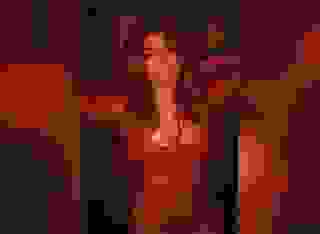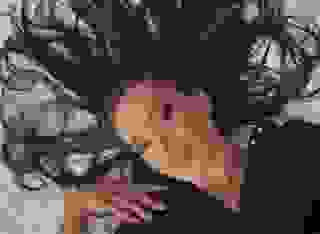Note: You can change font size, font face, and turn on dark mode by clicking the "A" icon tab in the Story Info Box.
You can temporarily switch back to a Classic Literotica® experience during our ongoing public Beta testing. Please consider leaving feedback on issues you experience or suggest improvements.
Click hereAt CCPD....
Detectives Upton and Lindsay were dping Officer Burgess. The three women then came hard, spurting their respective cumshots either inside of or on each other's bodies. Suddenly, their respective radio communicators went off. "Dispatch report," the radio said. "Possible indecent exposure. 345 Melody Blvd. Any officers please respond ASAP."
Officer Burgess took out her own radio communicator and activated it. "Officer Kim Burgess responding to the call from dispatch," she said. She then moaned as Upton and Lindsay pounded her snatch and anus, respectively.
Elsewhere in Central City....
A man was sitting in the living room. He was a curator of ancient bladed weapons of martial arts and combat. His collection contained many weapons.
He yawned and looked around. "Man," he said. "I should have slept in." He then left the living room and headed to bed.
A masked figure then appeared in the window. The figure was one of Stryker's agents. She snuck into the house and began to head towards the basement. Suddenly, she heard a noise. The man was coming back. She was going to have to finish him off quickly and quietly.
The man walked past his wall collection of bladed weapons. However, one was missing; the Ild. The Ild is a single-edged slashing sword. It was 36 inches long and weighed 3.5 lbs. The Ild had a curved, single-edged blade with a hilt designed for single-handed use. The degree of curvature varied greatly, from almost straight to nearly three-quarters of a circle. The ild was primarily a slashing weapon, with only slightly curved versions able to be used for thrusting. While effective from foot, its real value came from its use on horseback. With the spread of the Mongol empire, similar swords began appearing across Asia and Eastern Europe, including the Chinese dao, Persian shamsir, Russian Sablia, Indian talwar, Turkish kilij, European sabres, and naval cutlasses. It was very similar to the Chinese Pian Dao.
The man stopped and looked around. "Hello," he said. "Is someone there?" No response. He shrugged and sighed. "Maybe it was nothing." Before he could move forward, a slash of the Ild sword cut straight through his C3 and C4 vertebrae, cutting his head clean off. The assassin then collected all the weapons and vanished into the shadows.
The woman was a member of a group of assassins, called the League of Shadows. She headed to the clearing in the jungles.
She sighed deeply. "I can't believe I did not get caught," she said. "That was the easiest test ever."
"Easy, no," a voice said. "My child, nothing is ever easy."
The voice was Sensei. He was 74 years old. He had caucasian skin, long white hair, and brown eyes. He was the teacher of the members of the League of Shadows. He had no powers and abilities, but had different types of Ninja paraphernalia.
The woman bowed her head. "My apologies, Sensei," she said. "I failed to capture the data on the young speedster."
Sensei nodded. "The Great One wants to see you," he said. "I would suggest you go see him. The Great One doesn't like to be kept waiting."
The woman nodded. "I agree, Sensei," she said. She bowed her head and then took off running towards the Giajo Temple.
In the Giajo Temple, the Great One was sitting on a chair in the middle of the room. The Great One was named Ra's al Ghul. He was also known as The Demon's Head. He is 51 years old, physiologically. He is a human male with long black and gray hair and green eyes. He also had pale skin and a 14 inch long cock. Currently, he was getting a blowjob from one of his students.
The student was named Cheshire. Her real name was Jade Crock. She was known as Jade Nguyen. Jade was 30 years old. She was a human female with shoulder length black hair and black eyes. She had tanned skin. She bobbed her head up and down Ra's Al Ghul's cock.
Ra's moaned as he stroked Jade's head while she sucked his dick. Suddenly the unnamed female entered the room. "Great One," she said. "You asked to see me. Oh my god."
Ra's moaned and looked up at the woman. "Report to Lady Shiva and Cassandra Savage for training," he said as he facefucked Jade. "Now go." The woman nodded and left as the Great One came hard, spurting his spunk deep inside Jade's throat. Jade stood up and bowed her head. "I trust you will find out more about this young speedster and her team."
Jade nodded and began to leave. She stopped and turned around to face her teacher and leader. "Would the Great One like to have intercourse with me before I leave?" Jade said.
Ra's smiled and nodded. Jade began to strip naked. He untied her green kimono robe and removed it from her body. Jade was now fully naked, except for her black stockings and heels.
Jade was now completely under Ra's control. He turned her around and bent her over. He then lined his cock up with her young snatch. He thrusted hard inside Jade's snatch. Jade moaned as Ra's fucked her harder and deeper. "I'm gonna cum," Ra's moaned as he came hard, spurting his spunk deep inside Jade's snatch.
Jade hopped out and took off. Ra's smiled and nodded.
In an open field....
Lady Shiva and Cassandra Savage were training new recruits. All the recruits were young 18 year old girls. Their physical appearance varied, like their hair length, hair color, height, weight, eye color, skin color, breast size, cock size, body type, etc....
Lady Shiva smiled. Lady Shiva had pale skin. Her real name was Sandra Wu-San and was born in 1981. She is a human female with long black hair and brown eyes. "Remember, the sword is an extension of your arm," she said. "Every time you swing it, you must have full commitment and dedication."
Cassandra Savage stepped forward. Cassandra Savage was born in 2002. She is a human female with cropped brown hair and brown eyes. She had tanned skin. "Lady Shiva is right," she said. "But don't just strike with one. The extension of your arm means you can adapt the weapon as you see fit. Now, break into teams of two."
The unnamed female entered the area and bowed her head. "Lady Shiva," she said. "Forgive me for being late for training. I had to retrieve the items that you requested."
Cassandra grunted and struck the young woman across the face with the back of her hand, knocking the young woman down. "We don't teach forgiveness," Cassandra said. "Now, get into position and train." The woman nodded.
The training of the Shadows was brutal and severe. The trainees were trained to be assassins. Failure or resistance was often punishable by death. Each level is equal to four experience levels. The levels of the Shadows were the following;
Trainee - (Level 0 to 4)
Student - (level 5 to 9)
Follower - (Level 10 to 14)
Teacher - (Level 15 to 19)
Leader - (Level 20 to 24)
Master - (Level 25 to 29)
Grandmaster - (Level 30 or above)
The Shadows members were training using all of the following weapons;
Twin Hooks: The Hook Sword is an exotic Chinese weapon traditionally associated with Northern styles of Chinese martial arts, a razor sharp hand-held arsenal; four killing tools in one. Usually used in pairs, the Twin Hooks were one of the mid-range weapons. The Hook sword is shaped like a shepherd's hook. There are four main components to the weapon. The back, which is used like traditional swords. The hook, which is used for slashing, as well as catching weapons and tripping opponents. The end of the hilt, which are shaped into daggers. The crescent guard, which is used for blocking and slashing. Each of the Twin Hooks were 3 feet long, weighed 2 lbs, and made of forged steel. The Twin Hooks are primarily a slashing weapon, although the dagger ends can be used for stabbing. Another technique shown was to hook the two swords together, with the user swinging one, causing the dagger of the second sword to slash the opponent. There is little reliable information on the history of the weapon. They seem to be an exclusively civilian weapon, appearing in none of the official listings of Chinese armaments.
Gurj: The gurj is a type of mace used in the Indian martial art of Gatka. The gurj is an all-steel mace with a sword-like hilt. It had a flanged design (similar to the mace of the Mongol. Often, there were small openings in the head that gave a whistling noise when the gurj was swung. It was 4 feet long and weighed 4 lbs.
Staff: The Staff is a long, bludgeoning weapon, tough Chinese hard wood that delivered punishing blows without breaking. The staff is made from a single piece of white wax wood, which has been prized in China for centuries since it is tough and flexible, and can absorb shock without breaking. It is usually around the same height as the user. It was 5 feet long, weighed 1 lb, and made of wax wood. The staff was carried by the Shaolin monks whenever they left the monastery: making them designed for self defense without being as threatening as metal weapons like swords. It was used for bludgeoning, blocking, and keeping the opponent at a distance. Like many Shaolin weapons, it was not intended to be lethal. Staffs were also frequently used by revolting peasants and Ninjas. Similar stick weapons existed throughout the world. In England, they were called Quarterstaffs. In Ethiopia, the Surma/Suri tribes practiced Donga stick fighting.
Shuriken: The Shuriken is a traditional Japanese concealed weapon. It is 4 inches in length, 2 ounces in weight, and made of tempered steel. Shuriken were fashioned from everyday items: nails, needles, coins, washers, and other flat plates of metal. The most popular kind is the Hira-shuriken, often called Ninja Stars. These were flat disks with four blades, often with a hole in the center. The hole aided the aerodynamic and weighting effects of the shuriken, and could allow multiple shuriken to be strung on a string for transport. Contrary to their depiction in popular media, the shuriken was more of a distraction tool than a lethal weapon. They were often thrown at the enemy's eyes, or else thrown to cause a glancing cut, leading the opponent to believe they had been attacked by an invisible swordsman. Some may have been coated with poison, or allowed to rust so as to cause an infection (including Tetanus). The majority of shurikens are not designed to be lethal (unless they precisely hit an unarmored opponent in the eye, neck, heart, spine or back of the head). They are still a popular weapon as Ninjas can carry literally dozens of them into battle without being weighed down. According to the Shadows; the stars fly at about 45-50 mph. Shuriken was just one of many types of Shaken: which included small Chakram and various circular or spiral designs. Another iconic Ninja knife was the Kunai; a modified trowel. It was more lethal due to its larger size; however it was more frequently used for close combat and digging. Throwing darts were also commonly used by Ninja thanks to being similarly easy to conceal and carry. Ninjas made armband sheaths that could hold at least 3 darts (with some carrying over 6). These were located under the wrist to allow the Ninja to quickly grab the dart and then immediately throw it. These darts were easy to make out of common scrap metal or nails.
Sai: The Sai is a traditional weapon of Okinawa. Traditional sai were dagger-shaped bludgeoning tools, although more lethal designs are more common in modern pop culture. The sai consists of a long blade with a prong on either side of the blade, much like a trident with a elongated center prong. The handle ends in a large metal knob called the knuckle, which is used for striking. They were 18 inches in length, weighed 2 lbs, and consisted of a wooden handle and steel blades. Despite its traditional role as a defensive bludgeoning weapon, the sai is most often depicted as a more offensive weapon. It is used to stab with the central prong, while the outer forks can catch an opponents weapon. Very rarely are users depicted as striking with the knuckle, as was once common.
Katana: The Katana was a single-edged, curved Japanese sword, thirteen inches of folded steel and sharper than any razor. It was 30 inches long, weighed 2.5 to 3 lbs, and had a folded steel blade. The Katana is characterized by its distinctive appearance: a curved, slender, single-edged blade; a square or circular guard and a long grip to accommodate two hands. The blade is made from a specialized Japanese steel called Tamahagane, which combines hard, high carbon steel for the cutting edge and sides, and tough, low carbon steel for the core and back. This gives the blade a hard edge, while allowing it to absorb blows without shattering. The gentle curvature of the blade adds to the weapons cutting power by focusing the force of the blow on a smaller area. This curve is achieved during quenching: the sword maker coats the blade with several layers of a wet clay slurry, putting a much thinner layer on the front of the blade. When the blade is thrust in water, the front of the blade cools more quickly and hardens, while the slower cooling in the back of the blade reduces lattice strain on the spine, causing the blade to curve backwards. The Katana is a slashing sword, although in several attacks, the Samurai used it to stab an opponent to finish them off. The katana is worn at the waist with the "edge up" so that it can be drawn from the scabbard and cut the opponent in one swift motion. The Boshin War was the beginning of the end of traditional Samurai; yet the Katana was still effectively used in combat by both sides. The exception was when Gatling Guns were able to stop traditionalist units used by the Shogunate Army. The Shogun attempted to modernize, but the Imperialist rebels modernized earlier in the conflict and used their technological superiority to win the war. The Katana was seen by Imperialists as a sidearm; used only in shock Banzai Charges and only to be deployed as a close ranged ambush. The Katana was used as late as World War 2, as the Japanese still believed that swords can be effective in modern combat. The Japanese used Katanas and Bayonets in Banzai Charges to surprise the modern American soldiers; however most Banzai charges were costly at best and rarely were effective since Americans had machine guns and a Thomson Submachine Gun was issued to each 5 man squad. On July 7, 1944 during the Battle of Saipan; the Japanese forces realized they were losing the battle, and so in desperation led a 3000-4000 man Banzai Charge. The charge was surprising, but was a failure as the Americans successfully counter attacked: the majority of the Japanese were killed while 2000 Americans died on that day. Two days later, the Japanese officially surrendered. During the Battle of Iwo Jima; General Samaji Inouye opposed the idea of using Banzai Charges due to the clear evidence that they were mostly ineffective. Despite this; Captain Samaji Inouye led a 1000 man Banzai Charge on 8 March 1945 that resulted in 347 American casualties (90 deaths) and 784 Japanese deaths. After the war, the losing Imperial Japan had to surrender and destroy millions of swords as part of the peace treaty. The current state of Japan no longer issues katanas into the military but many traditionalist swordmakers still sell katanas and sword schools are still intact and popular across the country. Some Yakuza groups still use swords in their assassinations.
Nunchaku: Nunchaku, also known as nunchucks, are traditional Okinawan weapons. The nunchaku consists of two sticks connected by a short chain. The sticks are usually wooden or metal, although rubber and plastic ones also exist. They are each 3 feet long, weighed 2 lbs, and consisted of two wooden poles connected with a steel chain. The nunchaku was a farming tool commonly used for thrashing grain. Like many other farming tools, it was occasionally adapted as an improvised weapon. The nunchaku is a bludgeoning weapon that uses the momentum from a swing to increase the impact. However, tests have shown that some of the impact is absorbed by the weapon's flexibility. The weapon also requires a good deal of training to be effective in a fight. Many believe that the nunchaku was originally used in ancient China as a farming tool before being adapted in Okinawa to be used in battle. While famously depicted as a ninja weapon, the nunchaku were rarely used by armies of any kind except by protesting farmers or basic criminals. Some historians believe that the nunchaku had virtually no historical use and was popularized primarily because of Bruce Lee.
Katar: The Katar or Katara is distinctive for its H-shaped handle, which places the blade directly over the wearer's knuckles. This makes it a very effective punching weapon. The Katar is used for punching stabs to opponents, and is effective due to its speed and penetrating power. The sides of the H-shaped handle could also be used to block. It was designed to be able to pierce the armor used in Asia. The Rajput sometimes used two katar simultaneously, wielding them in both hands. The Katar had many variants, one notable one being the Jamadhar Katar, or "scissor katar", which was shown. This variant had blades that would fan out, which would be used to surprise or disarm opponents. Later models of Katar would sometimes include two single-shot pistols in the hilt. The katar was tested on a pig carcass. The Rajput stabbed and slashed the carcass multiple times, producing 200 pounds of force from the punches. The katar succeeded in disemboweling the carcass and breaking through the ribs. On a second pig carcass they placed the Roman chainmail to see if the katar could get through the armor. The armor proved little protection against the katar, it was like a T-Shirt for that weapon.
Khanda: The Khanda is a straight-bladed sword unique to India and a traditional Sikh and Rajput sword. The Khanda has a straight, double-edged blade that broadens near the tip. The blade itself is quite broad and heavy, and transforms into the tip rather abruptly. The hilt has a metal spike coming out of the bottom that is typical of the Khanda. Unlike other straight-bladed swords, the Khanda is poorly designed for thrusting, instead being used for hacking and slicing. Combined with the Indian martial art style known as Gatka, the Sikhs managed to achieve tremendous cutting power with this weapon. The Sikhs venerated the Khanda as a weapon of great prestige and honor, It had roughly the same place in Sikh's warrior classes as the Katana did to the Samurai. Sikh warriors in battle wielded the khanda with both hands and swung it over their head when surrounded and outnumbered by the enemy. It was in this manner that they traditionally committed an honorable last stand rather than be captured.
Kilij: The Kilij was a curved Turkish sword. The Kilij had a deeply curved, single edged blade with a flaring tip called a yelman. It has a cruciform (cross-shaped) guard, with a curving hilt that ends with a downturned pommel. The Kilij was primarily a slashing weapon, as its great curvature made it difficult to thrust the weapon. The yelman added weight to the tip, giving it greater momentum when swung. Used by the Ottoman Turks, it was (ironically) adopted by Vlad the Impaler, who was the last line of defense between the Turks and Western Europe. The tip is very sharp for stabbing, though because of its design it has to stab diagonally. This creates a fighting style that can go around shields and can be harder to block from swinging stabs. It can be used as a great decapitater. It was often tested against the Jian. It proved capable of slicing a pig in half with one swing (Its cutting power prompting Savage to call it the first sword to rival the katana). While the Jian was a superior thrusting weapon, the Kilij was given the edge due to the greater amount of damage it could do.
Kukri: The Kukri is a curved Nepalese knife used as both a tool and a weapon. The kukri has a heavy, forward-curved blade with a single cutting edge and a circular notch near the handle. It typically has a length of 16-18 inches (40-45 cm) and weighs 1 to 2 lbs (450 to 900 grams). It is similar in shape to the Iberian falcata and the Greek Kopis, it is even theorized to have been developed from the latter when it was introduced into India by Alexander the Great. The small notch in the lower part of the blade is symbolic of the trident of the Hindu deity Shiva. It also makes sure that blood dripping from the tip drops off the blade and does not reach the handle and make the wielder's hands slippery. The kukri is primarily used for chopping, as the shape of the blade causes the blade to fall on the target faster and with more power. Despite a popular legend that a Gurkha 'never sheathes his blade without first drawing blood', the kukri is most commonly used as a multi-use utility tool like a machete. The kukri is the icon of Nepal, and is a symbolic weapon of the Nepalese Army and all Gurkha regiments around the world. This weapon was tested against the camillus in eliminating 3 targets (2 guards, 1 pop-up). Although both weapons scored 3 kills with the camillus having a higher strike force of 81 mph to the kukri's 59 mph, the edge was given to the kukri for its larger blade.








